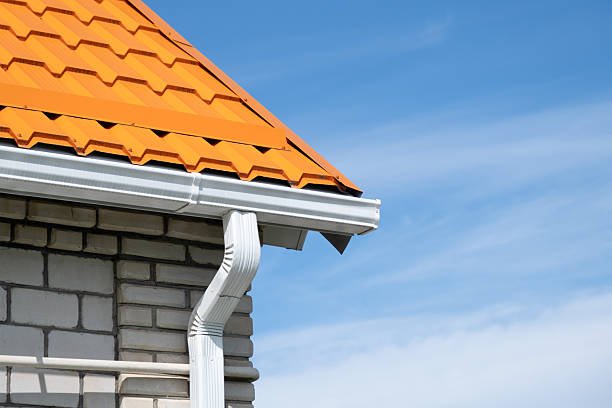When it comes to protecting your home from rainwater damage, the choice between seamless gutters and regular gutters can make a real difference. In this article, we’ll walk through what sets regular gutters apart, when they’re a viable choice, and how they compare to seamless systems in terms of performance, cost, and maintenance. Our aim is to give you the clarity you need to make an informed decision — whether you’re replacing an old gutter system or installing one for the first time.
What Are Regular Gutters?
Regular gutters are usually factory- or store-bought in fixed lengths (often 10 to 20 feet), and are installed by joining together multiple sections using connectors and sealants. This sectional installation means the system has visible seams or joints at the connection points. These gutters can be made of materials like vinyl, steel, aluminum, or even copper, depending on budget and aesthetic preference.
Advantages of Regular Gutters
- Lower upfront cost: Generally the cheapest option to install since sections are standard-sized and less custom fabrication is required.
- Easy replacement of sections: If a section gets damaged, you can often replace just that part rather than the full run.
- Flexibility: Because they come in sections, they can be adapted or adjusted more easily during installation or repair.
- Availability: Since many retailers stock them, you may have more options immediately available and fewer lead-time delays.
Drawbacks of Regular Gutters
- Leak potential at seams: Each joint is a potential point of failure over time — sealants may deteriorate, and connectors may loosen, which can lead to leaks.
- Debris accumulation: The seams provide crevices where leaves, twigs, and other debris can gather, which may obstruct flow and require more frequent cleaning. For example, vinyl gutters are described as “the weakest material” and more susceptible to elements and damage.
- Durability concerns: Some materials used in regular gutters (especially vinyl) may crack under extreme weather or prolonged exposure. The article from the blog points out that while steel or aluminum regular gutters “with proper maintenance can last decades,” they’re still more vulnerable at the seams.
- Maintenance burden: Because of the seams and potential weak points, regular gutters often require more frequent inspection, cleaning, and sealing versus seamless options.
When Regular Gutters Make Sense
Regular gutters can be a very acceptable choice in several scenarios:
- If budget is a major constraint and you need an affordable solution with acceptable performance.
- On simpler roofs or home layouts where runs are short, and there are fewer corners or complex runs (thus fewer joints).
- If you’re comfortable with periodic maintenance (cleaning out seams, checking for leaks, resealing connectors).
- When you anticipate making changes to your gutter system (e.g., future modifications or expansions) and you want a system that’s arguably easier to adjust or repair section-wise.
How Regular Gutters Compare to Seamless Systems
Seamless gutters are typically custom-cut on site to match the length of your home’s roof edge, meaning there are far fewer joints (often only at corners or downspout junctions). As the blog from Frogtown Roofing Plus notes, “Because of their lack of seams, these gutters are the least likely to have leakage.
So compared to regular gutters:
- Leak risk: Seamless has fewer joints → less risk. Regular gutters have more joints which increase the likelihood of leaks over time.
- Debris build-up: Regular gutters’ seams can trap debris; seamless options reduce that risk.
- Maintenance: Less upkeep with seamless; regular gutters often need more attention.
- Cost: Regular gutters are typically less expensive initially; seamless systems carry a premium but may save money long-term via less maintenance and fewer replacements.
- Durability: Seamless tends to last longer with fewer weak points. Regular gutters can last decades if well maintained but often have more potential failure points.
Tips for Maintaining Regular Gutters
If you opt for regular gutters, here are some good practices to maximize lifespan and performance:
- Inspect seams and connectors regularly: Look for signs of leakage, rust (in steel), cracking (in vinyl), or separation at joints.
- Clean out debris: Because seams tend to collect leaves, dirt and branches, cleaning at least twice a year (spring and autumn) is wise.
- Seal and repaint connectors if needed: Especially after heavy weather, reseal or replace sealant around joins to prevent leaks.
- Watch for sagging or separation: If sections start to sag or pull away from the fascia, the run may become inefficient or overflow.
- Consider gutter protection: Installing guards or mesh can reduce debris entry and ease cleaning. As the blog mentioned: “Gutter protection can help keep your gutters free of debris.
- Choose good materials: If you use sectioned gutters, choosing a more durable material (e.g., aluminum or copper rather than vinyl) improves longevity—even with the regular gutters format. The blog highlights that “copper and aluminum gutters are not susceptible to rust” compared to steel or vinyl.
Final Thoughts
Regular gutters remain a practical, cost-effective guttering solution for many homeowners, especially when budget and simplicity are major concerns. They do come with extra maintenance and a higher potential leak-risk compared to seamless systems, but with good care, they can serve your home well for years.
If you’re evaluating your options and wondering whether to stick with regular gutters or invest in a seamless system, our team at frog town roofing is here to help. We’ll walk you through the pros and cons, assess your roof layout, usage patterns and budget, and help you make the best choice for your home’s long-term protection and performance. Let’s connect and get your gutters working smarter for you!
